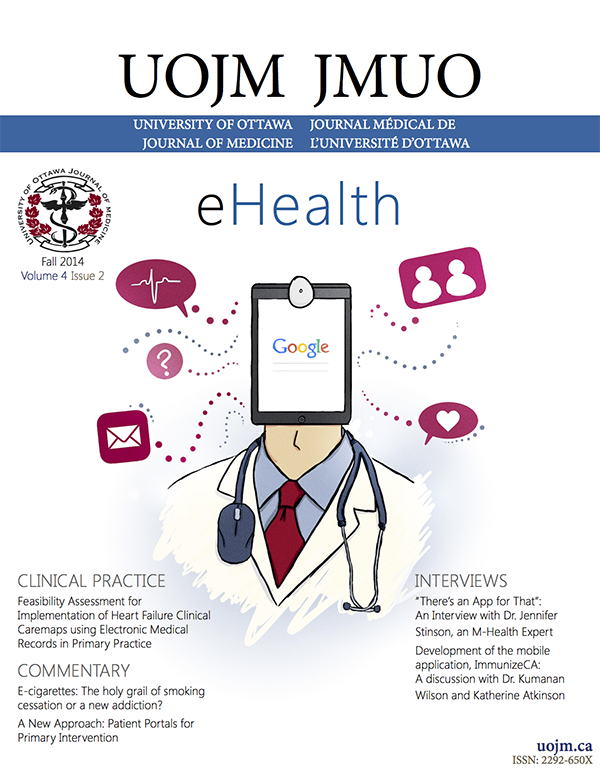“There’s an App for That”: An Interview with Dr. Jennifer Stinson, an M-Health Expert
DOI:
https://doi.org/10.18192/uojm.v4i2.1144Keywords:
m-health, e-healthAbstract
Increased adoption of smartphone technology by the general public has opened up an exciting new means by which healthcare professionals can interact with their patients [1]. The smartphone’s unique ability to combine mobile communication and computation offers a novel modality by which physicians can deliver healthcare interventions to their patients. Thus, it is no wonder that the use of smartphones in healthcare settings (so called “m-health”) has become the focus of widespread interest amongst healthcare professionals, with many smartphone-based medical applications already in widespread use amongst physicians and patients [2].
Leading the charge in this m-health revolution is Dr. Jennifer Stinson, a nurse clinician scientist based at The Hospital for Sick Children in Toronto, who aims to capitalize on the popularity of smartphones among adolescents [3]. Dr. Stinson is a pioneer in the field of m-health, creating one of the first electronic pain diaries using the Palm Tungsten PDA to help adolescents with juvenile idiopathic arthritis (JIA) related pain [4]. More recently, she has created the “Pain Squad” smartphone-based app, a multiple award-winning pain measurement tool for children and adolescents with cancer [5].
I was able to speak with Dr. Stinson about her experience with m-health, her views about the future of m-health, and her advice for interested healthcare professionals and trainees who want to integrate mobile technology into their own patient care. The following is an edited version of that conversation.
References
2) Mosa AS, Yoo I, Sheets L. A systematic review of healthcare applications for smartphones. BMC Med Inform Decis Mak. 2012 Jul 10;12:67.
3) Madden M, Lenhart A, Duggan M, Cortesi S, Gasser U. Teens and Technology 2013. Washington, DC: Pew Research Center, Internet and American Life Project; 2013 Mar 13 [cited 2014 Aug 13]. Available from: http://www.pewinternet.org/Reports/2013/Teens-and-Tech.aspx.
4) Stinson JN, Petroz GC, Tait G, et al. E-Ouch: usability testing of an electronic chronic pain diary for adolescents with arthritis. Clin J Pain. 2006; 22(3):295-305.
5) Communications at SickKids. Pain Squad Mobile App. Toronto, Ontario: The Hospital for Sick Children. 2012 May [cited 2014 Aug 13]. Available from: http://www.campaignpage.ca/sickkidsapp/.
6) Lalloo C, Jibb LA, Agarwal A, et al. “Theres’s a Pain App for That”: Review of Patient-Targeted Smartphone Applications for Pain Management. Manuscript submitted for publication.
7) Health on the Net Foundation. About HON. Geneva, Switzerland: Health on the Net Foundation; 2013 Jun 5 [cited 2014 Aug 15]. Available from: http://www.hon.ch/Global/index.html.
Downloads
Published
Issue
Section
License
- Authors publishing in the UOJM retain copyright of their articles, including all the drafts and the final published version in the journal.
- While UOJM does not retain any rights to the articles submitted, by agreeing to publish in UOJM, authors are granting the journal right of first publication and distribution rights of their articles.
- Authors are free to submit their works to other publications, including journals, institutional repositories or books, with an acknowledgment of its initial publication in UOJM.
- Copies of UOJM are distributed both in print and online, and all materials will be publicly available online. The journal holds no legal responsibility as to how these materials will be used by the public.
- Please ensure that all authors, co-authors and investigators have read and agree to these terms.
- Works are licensed under a Creative Commons Attribution-NonCommercial-NoDerivatives 4.0 International License.


